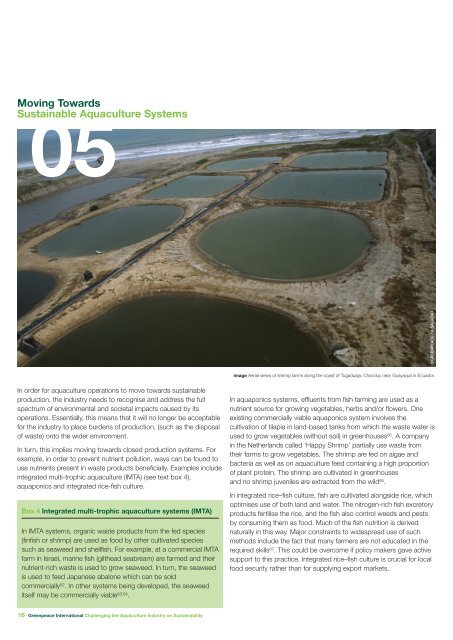Challenging the Aquaculture Industry on Sustainability-Greenpeace ...
Challenging the Aquaculture Industry on Sustainability-Greenpeace ...
Challenging the Aquaculture Industry on Sustainability-Greenpeace ...
Create successful ePaper yourself
Turn your PDF publications into a flip-book with our unique Google optimized e-Paper software.
Moving Towards<br />
Sustainable <str<strong>on</strong>g>Aquaculture</str<strong>on</strong>g> Systems<br />
05<br />
©GREENPEACE / A SALAZAR<br />
image Aerial views of shrimp farms al<strong>on</strong>g <str<strong>on</strong>g>the</str<strong>on</strong>g> coast of Tugaduaja, Chanduy near Guayaquil in Ecuador.<br />
In order for aquaculture operati<strong>on</strong>s to move towards sustainable<br />
producti<strong>on</strong>, <str<strong>on</strong>g>the</str<strong>on</strong>g> industry needs to recognise and address <str<strong>on</strong>g>the</str<strong>on</strong>g> full<br />
spectrum of envir<strong>on</strong>mental and societal impacts caused by its<br />
operati<strong>on</strong>s. Essentially, this means that it will no l<strong>on</strong>ger be acceptable<br />
for <str<strong>on</strong>g>the</str<strong>on</strong>g> industry to place burdens of producti<strong>on</strong>, (such as <str<strong>on</strong>g>the</str<strong>on</strong>g> disposal<br />
of waste) <strong>on</strong>to <str<strong>on</strong>g>the</str<strong>on</strong>g> wider envir<strong>on</strong>ment.<br />
In turn, this implies moving towards closed producti<strong>on</strong> systems. For<br />
example, in order to prevent nutrient polluti<strong>on</strong>, ways can be found to<br />
use nutrients present in waste products beneficially. Examples include<br />
integrated multi-trophic aquaculture (IMTA) (see text box 4),<br />
aquap<strong>on</strong>ics and integrated rice-fish culture.<br />
Box 4 Integrated multi-trophic aquaculture systems (IMTA)<br />
In IMTA systems, organic waste products from <str<strong>on</strong>g>the</str<strong>on</strong>g> fed species<br />
(finfish or shrimp) are used as food by o<str<strong>on</strong>g>the</str<strong>on</strong>g>r cultivated species<br />
such as seaweed and shellfish. For example, at a commercial IMTA<br />
farm in Israel, marine fish (gil<str<strong>on</strong>g>the</str<strong>on</strong>g>ad seabream) are farmed and <str<strong>on</strong>g>the</str<strong>on</strong>g>ir<br />
nutrient-rich waste is used to grow seaweed. In turn, <str<strong>on</strong>g>the</str<strong>on</strong>g> seaweed<br />
is used to feed Japanese abal<strong>on</strong>e which can be sold<br />
commercially 62 . In o<str<strong>on</strong>g>the</str<strong>on</strong>g>r systems being developed, <str<strong>on</strong>g>the</str<strong>on</strong>g> seaweed<br />
itself may be commercially viable 63,64 .<br />
In aquap<strong>on</strong>ics systems, effluents from fish farming are used as a<br />
nutrient source for growing vegetables, herbs and/or flowers. One<br />
existing commercially viable aquap<strong>on</strong>ics system involves <str<strong>on</strong>g>the</str<strong>on</strong>g><br />
cultivati<strong>on</strong> of tilapia in land-based tanks from which <str<strong>on</strong>g>the</str<strong>on</strong>g> waste water is<br />
used to grow vegetables (without soil) in greenhouses 65 . A company<br />
in <str<strong>on</strong>g>the</str<strong>on</strong>g> Ne<str<strong>on</strong>g>the</str<strong>on</strong>g>rlands called ‘Happy Shrimp’ partially use waste from<br />
<str<strong>on</strong>g>the</str<strong>on</strong>g>ir farms to grow vegetables. The shrimp are fed <strong>on</strong> algae and<br />
bacteria as well as <strong>on</strong> aquaculture feed c<strong>on</strong>taining a high proporti<strong>on</strong><br />
of plant protein. The shrimp are cultivated in greenhouses<br />
and no shrimp juveniles are extracted from <str<strong>on</strong>g>the</str<strong>on</strong>g> wild 66 .<br />
In integrated rice–fish culture, fish are cultivated al<strong>on</strong>gside rice, which<br />
optimises use of both land and water. The nitrogen-rich fish excretory<br />
products fertilise <str<strong>on</strong>g>the</str<strong>on</strong>g> rice, and <str<strong>on</strong>g>the</str<strong>on</strong>g> fish also c<strong>on</strong>trol weeds and pests<br />
by c<strong>on</strong>suming <str<strong>on</strong>g>the</str<strong>on</strong>g>m as food. Much of <str<strong>on</strong>g>the</str<strong>on</strong>g> fish nutriti<strong>on</strong> is derived<br />
naturally in this way. Major c<strong>on</strong>straints to widespread use of such<br />
methods include <str<strong>on</strong>g>the</str<strong>on</strong>g> fact that many farmers are not educated in <str<strong>on</strong>g>the</str<strong>on</strong>g><br />
required skills 67 . This could be overcome if policy makers gave active<br />
support to this practice. Integrated rice–fish culture is crucial for local<br />
food security ra<str<strong>on</strong>g>the</str<strong>on</strong>g>r than for supplying export markets.<br />
16 <strong>Greenpeace</strong> Internati<strong>on</strong>al <str<strong>on</strong>g>Challenging</str<strong>on</strong>g> <str<strong>on</strong>g>the</str<strong>on</strong>g> <str<strong>on</strong>g>Aquaculture</str<strong>on</strong>g> <str<strong>on</strong>g>Industry</str<strong>on</strong>g> <strong>on</strong> <strong>Sustainability</strong>












